PPA Electrifier Compact CR Economy Manual de usuario
- Tipo
- Manual de usuario

INSTALLER MANUAL
COMPACT CR ECONOMY
P30349 - 10/2022
Rev. 1
WARNING:
Do not use the equipment
without referring to this
manual rst.
ATTENTION
Please read this manual carefully and follow its instructions to install / use the equipment.
This equipment complies with the ABNT NBR IEC 60335-2-76: 2007 standard.
It is very important to maximize information to children and neighbors about the purpose of the fence and its danger.
This appliance is not designed to be used by persons (including children) with reduced physical, sensory or mental
capabilities, or by persons with a lack of experience and knowledge, unless they have been instructed in the use of
the appliance or are under the supervision of a person responsible for their safety, it is recommended that children
are supervised to ensure that they are not playing with the appliance.
The installation or maintenance of this equipment should only be carried out by a specialized technician.
The equipment and the fence electrified by it must be installed in such a way that they only provide the risk of electric
shock to persons who try to cross the physical barrier, or find themselves in the protected area without authorization.
The construction of the electric fence must not allow accidental entrapment of people.
An electric fence should not be powered by two separate electrifiers. The distance between the cables of two
separate electric fences must be at least 2.5 m. This spacing can be less, where the conductors or connecting
conductors covered by insulating covers consist of cables with insulation of at least 10KV. This requirement does not
apply when these conductors are separated by a physical barrier that does not have openings greater than 50 mm.
The equipment's 127V / 220V power supply wiring must have a protection switch that allows turning off the power
without having to open the equipment cabinet to connect the equipment to the network, a power cable with an
accessible plug must be used to the user. Always turn off the equipment, disconnect the battery and interrupt the
127V / 220V power supply before cleaning / pruning vegetation by touching the fence wires or performing any
maintenance on the board / electric fence.
Use 2 wires of 20 AWG (0.5 mm²) to connect to the network. To connect the board to the fence, use high insulated
wire.
The connecting conductors installed underground must be placed inside conduits of insulating material or else an
insulating cable for high voltage must be used, care must be taken to avoid damage to the connecting conductors
due to pressure from the vehicle wheels against the floor. Fence wiring can be galvanized wire, bare copper, or
stainless steel wire, barbed wire, or shear wire that should not be electrified. Whenever possible, install the
equipment on the ground floor, avoiding its installation on upper floors.
The fence must be installed only in the domain owned by the client, and always in accordance with the requirements
of the ABNT NBR IEC 60335-2-76: 2007 standard specified in annexes BB.2 and CC.1.
The connecting conductors and wires of the electrical safety fence must not pass over overhead power lines and / or
communication lines. Crossing overhead power lines should be avoided. If such a crossing cannot be avoided, it
should be done below the power line so that it is perpendicular to the line.
The separation distances between the wires of the electric fence and the electric power line must not be less than
those indicated in table BB.2 of the ABNT NBR IEC 60335-2-76: 2007 standard shown below:
Power line
voltage (V) Separation
distance (M)
_
< 1000
_
> 1000 and < 33000
> 33000
Electric safety fences must be identified by warning signs installed so that they are conspicuous. Said warning signs
must be legible from the protected area and the public access area. Each side of the electric fence must have at least
one warning sign. warning signs should be installed: on each door; at each access point: at intervals not exceeding
10 m: adjacent to each sign related to chemical hazards for information regarding emergency services. The size of
the warning sign must be at least 100mm x 200mm with a minimum font size of 25mm and the background color on
both sides of the sign must be yellow. The inscription on the plate must be black and contain the text 'CAUTION -
Electric fence' or the 'warning sign' symbol (Figure BB.1, page 2)
ATTENTION: DO NOT CONNECT THIS APPLIANCE TO EQUIPMENT SUPPLIED BY THE ELECTRICAL
NETWORK
It must be ensured that all auxiliary equipment powered by the electrical network, connected to the circuit of the
electrical safety fence, has a degree of isolation from the fence and the electrical network equivalent to that assigned
to the electrifier.
NOTE 1 - Auxiliary equipment that meets the requirements related to the isolation between the fence circuit and the
electrical network in paragraphs 14, 16 and 29 of the standard for the electric fence electrifier is considered to have
an isolation level suitable.
Weather protection must be provided for auxiliary equipment, unless this equipment is certified by the manufacturer
as suitable for use in outdoor environments and with a minimum degree of protection IPX4
Figure BB.1 - Warning signaling symbol.
Installation conditions
- The gates of electric security fences must be able to be opened without the person receiving an electric shock.
- The exposed conductive parts of the physical barrier must be earthed efficiently.
- Where an electrical safety fence passes under uninsulated power line conductors, its tallest metallic element
must be efficiently grounded at a distance of not less than 5 m on both sides of the crossing point.
- If the connecting conductors and wires of the electrical safety fence are installed near overhead power lines,
their height from the ground should not exceed 3 m. This height applies to either side of the orthogonal projection
of the outermost conductors of the electric power line on the ground surface, at a distance of:
1) 2 m for electric power lines operating at a nominal voltage not exceeding 1000 V;
2) 15 m for electric power lines operating at a nominal voltage greater than 1000 V; A vertical distance of not less
than 2 m should be maintained between conductors energized by pulses of different electrifiers.
Connecting conductors installed inside buildings must be efficiently insulated from structural parts of the
building. This can be achieved by using a high voltage insulating wire.
The equipment is intended for property security and is intended for peripheral protection of residential properties,
businesses, condominiums, industries, etc. This protection is carried out through the electrification of fences
installed on the walls or bars of the property. The basic function is to prevent intruders from entering the protected
area, generating a non-fatal electric shock to those who come to touch the wiring of the electric fence.
Technical characteristics
AC power: 127V / 220V
DC power supply: 12V 7ah (we recommend to use stationary gelatinous dry battery),
During charging, lead-acid batteries should be placed in a well-ventilated place.
Do not use non-rechargeable batteries.
Consumption: 5Watts. (The power is the same for the two voltage ranges 127V / 220V)
Nominal frequency: 60 Hz.
Output voltage: 10kV pulsing
Accumulated energy: 0.5J
Pulse repetition rate: <1 Hz.
Output pulse duration: 50 us.
Battery life: 12 hours.
Maximum cable length: 1,200 m of electrified cable.
Example:
1,200m, about 4 wires. Maximum length of the wall 300 m.
Receiver frequency: 433.92 MHz
Terminal identification (See figure 1).
AC: It is used to connect the electrical network to the equipment.
BAT +: Battery input. Use only a 12V / 7Ah sealed rechargeable battery with dimensions of 15.0 x 9.5 x 6.5
(cm). The board always keeps the battery fully charged.
SIR +: Siren output. To use this function, the positive siren wire must be connected to the 'SIR +' pole and the
negative to the 'GND' pole, the JMP1 must be closed and the board connected to a 12v / 7Ah battery.
Output voltage: 12.5 Vdc.
Maximum current: 3A
CO: Common
NF: normally closed
Used to connect highly insulated fence wires to equipment.
GROUND: Used to connect the ground rod.
Jumpers identification (see figure 1)
JMP1
Open: CO / NO / NC output enabled for connection to the alarm system.
Closed: siren output (SIR +) enabled.
JMP4
Open: Enables the arm / disarm beep on the SIR + output.
Closed: Enables the arm / disarm beep on the BIP- output.
Remote control setup (see figure 1)
The "C" (shock) key is used to turn on / off the electrification of the electric fence. When turning it on, the
board will emit a short beep and when turning it off, it will emit two short beeps.
The "P" (panic) key is used to activate the siren in an emergency situation, in order to defend against a
possible intruder.
The 'A' key (sensors) is used to turn on / off the alarm sector (wireless sensors) of the board. When the board
is switched on it will emit a short beep and when it is switched off it will emit two short beep.
The alarm sector can be activated independently of the download function.
NOTE: When a fence trip occurs, the siren can be turned off using any control key.
Each control has a unique coding, so the board needs to register the code of each control, to carry out this
procedure the following steps must be carried out:
Step 1: Press and hold the "PROG" button, therefore the "PULSE LED" will light.
Step 2: Press any key on the control, until the board emits a short beep on the siren, indicating that the
recording was successful. This procedure should be done as soon as possible to avoid writing unwanted
code.
NOTE: Up to 42 codes can be recorded in the board, when all the codes are used and each time you try to
record a new code, the 'PULSE LED' will blink indicating that the board memory is full.
To erase all memory from the boar, the following steps must be performed:
Step 1: Completely de-energize the board.
Step 2: Keep pressing the "PROG" button and power the board again, after this procedure the "PULSE
LED" will light up for 1 second indicating that the board memory has been deletedera
LED identification (see figure 1)
LED 'ON'
Slow flashing: indicates that only the download function is activated.
Fast flashing: indicates that only the alarm sector is on.
On: indicates that the shock function and alarm sector are on.
When the "TRIGGER" led is on, it indicates a trip condition (alarm).
'PULSE' LED
Slow flashing: indicates a satisfactory pulse return and the fence is normal.
On: Indicates that the switch is in wireless remote control / sensor recording mode.
Fence
GROUND
Ground rod
PULSE
Alarm
output
BATTERY
POWER
SUPPLY
10V ~ 220V
SHOOTING SWITCHED ON
Figure 1
Installation kit
This equipment must be fixed to a wall using screws and dowels, in a vertical position (as shown in
figure 2), protected from the sun and rain, so that the user cannot change the position without the
help of tools.
BOARD
SMD
Cover fixing screws
Correct position (vertical)
for fixing the equipment
to the wall.
Figure 2
The equipment and the electrifying fence must not be installed in places where especially
dangerous conditions prevail, such as explosive atmosphere, flammable or corrosive liquids, etc.
At the end of the installation, always close the equipment using the screws to fix the cover to the
bottom of the plastic cabinet.
Figure 3 shows the size of the plastic enclosure, the distance between the wall fixing screws and
the entries for the high insulation cables, the switch AC power cable, the ground cable and the
peripheral equipment cables.
High insulation
cables Power cable
Ground cable and cables
for peripheral equipment
The following figures show how the power cord should be installed.
In figure 4 how the
cable should be
through the anchor
of the box.
Figure 4
In figure 5 we see how
to secure the cable using
the cable gland.
The power cord must be
at least
2x20 AWG (0.5mm²).
Figure 5
Attention! The PP part should always be connected to the board as shown in figure 6.
Figure 6
To ground the board, we recommend using a rod of at least 1.80 m with a connector embedded in the ground.
The ground must be of good efficiency and specific to the shock unit. The distance between any ground
electrode of an electric safety fence and other grounding systems should not be less than 2 m, except when
associated with a grounding mesh.
Connection of the electric fence
to the board.
INTERCONNECT POINT "A" TO TARGET "OUTPUT"
AND POINT "B" TO TARGET "INPUT"
USING A HIGH INSULATION CABLE
SIREN
EXIT
FORBIDDEN
Earth
INITIAL
ROD
CAUTION!!!
ELECTRIC
FENCE
CAUTION!!!
ELECTRIC
FENCE
FINAL
ROD
WARNING TABLES
INSTALLED EVERY 10 MTS
WIRE CLOSE
Attention!
The length of the wire is given by the sum total of all the wires in the electric fence. For this
model, we indicate a maximum total distance of 1200 m and a minimum width of 0.45 mm, cross
section of 0.162 mm² or 25 AWG.
Rods
- The rods must always be inclined towards the user's property.
- We recommend the use of flat aluminum bars, as shown in figure 7.
- Insulators must be tested to withstand up to 25,000 V dry and 20,000 V in rain without showing
voltage leakage. We do not recommend using porcelain insulators to install electrified fence wiring,
as they can present frequent tripping problems in the rain.
The board does not turn on: Check the electrical network and the protection fuse FUSE01 (5A).
Does not shoot: Check the entire length of the fence and check if the fence net series is correct.
False Shots: Vegetation over fence wires, broken fence wires, fence wires touching walls,
flashing, fences, etc.
Telephone interference: poor ground wire contact, very long and thin ground wiring, weak
ground, wires installed too close to the telephone exchange, highly insulated wires running close
to the telephone wire, grounded customer telephone line (wire poorly insulated phone inside the
water pipes).
Interference in electronics: Same causes as the problem of interference in the telephone,
more bad contact in the electric fence (welds and bad splices), high insulation cables that pass
directly over metallic flashes, gutters, walls, floors, slabs, etc.
INSULATING
INSULATING
INSULATING
INSULATING
1 "X 1/4 ALUMINUM OR IRON ROD
8 OR 10
SOCKET SCREWS
MASONRY
WALL
THE RODS MUST ALWAYS
BE INCLINED WITHIN
THE USER'S PROPERTY
Figure 7
ATTENTION!
Diagram of connection to the electrical network
TERMINALS
TERMINALS
ATTENTION: replacement or maintenance of the power cord should only be performed by an
authorized agent or installation agent.
PROBLEMS AND POSSIBLE CAUSES
Installation Considerations
- The gates of electric security fences must be able to be opened without the person receiving an electric
shock.
- The exposed conductive parts of the physical barrier must be earthed efficiently.
- When an electrical safety fence passes under uninsulated power line conductors, its tallest metal
element must be efficiently grounded at a distance of not less than 5 m on either side of the crossing
point.
- If the connecting conductors and wires of the electrical safety fence are installed near overhead power
lines, their height from the ground should not exceed 3 m. Is
the height is applied to each side of the orthogonal projection of the outermost conductors of the electric
power line on the ground surface, for a distance of:
1) 2 m for electric power lines operating at a nominal voltage not exceeding 1000 V;
2) 15 m for electric power lines operating at a nominal voltage greater than 1000 V;
A vertical distance of not less than 2 m should be maintained between conductors energized by pulses of
different electrifiers.
Connecting conductors installed inside buildings must be efficiently insulated from the building's
insulated structural equipment. This can be achieved by using a high voltage insulating wire.
GENERAL TERMS AND CONDITIONS OF WARRANTY
MOTOPPAR, Industry and Commerce of Automatic Gate Operators Ltd., registered with
the CNPJ (National Registry of Legal Entities) under Number 52.605.821/0001-55,
located at 3526 Dr. Labieno da Costa Machado Avenue, Industrial District, Garça – SP –
Brazil, Zip Code 17400-000, manufacturer of PPA Products, hereby guarantees this
product against design, manufacturing or assembly defects and/or supportively as a result
of material quality flaws that could make its intended use improper or inadequate, within a
legal period of ninety days from time of acquisition, provided that the installation
instructions described in the instruction manual are observed.
Due to the credibility and trust placed on PPA products, we will add 275 more days to the
period mentioned above, reaching a warranty period of one year, likewise counted from
the time of acquisition proven by consumer through proof of purchase (Customer Receipt).
In case of defect, within the warranty period, PPA responsibilities are restricted to the
repair or substitution of the product manufactured by the company, under the following
conditions:
1. Repair and readjustment of equipment may only be carried out by PPA Technical
Assistance, which is qualified to open, remove, and substitute parts or components,
as well as repair defects covered by this warranty; thus, failure on observing this
guideline and the verified use of any non-original parts will cause the resignation of
this warranty on the part of the user;
2. The warranty will not extend to accessories such as cables, screw kit, fixing brackets,
power supplies etc.;
3. Expenses for packaging, transportation and product reinstallation will be sole
responsibility of the consumer;
4. The equipment must be sent directly to the Company responsible for the sale
(manufacturer's representative), through the address contained in the purchase
invoice, properly packed, thus avoiding loss of the warranty;
5. Within the additional period of 275 days, visits and transportation in places where
authorized technical assistance is not available will be charged. The cost of
transportation of the product and/or technician will be sole responsibility of the
consumer and
6. The substitution or repair of the product does not prolong the warranty time.
This warranty will be terminated if the product:
1. Is damaged by natural agents, such as atmospheric discharges, floods, wildfires,
landslides etc.;
2. Is installed in an improper electric power supply or if it is not according to any of the
installation instructions displayed on the manual;
3. Shows defects caused by droppings, collisions or any other physical accident;
4. Shows signs of product violation or attempted repair by unauthorized personnel;
5. Is not used for its intended purpose;
6. Is not used under normal conditions;
7. Is damaged by accessories or equipment connected to it.
Recommendation:
We recommend that both the installation and the maintenance of the operator to be
performed by an authorized PPA technical service. If the product fails or has an improper
operation, seek an Authorized Technical Service to fix it..
Made by: Motoppar Indústria e Comércio de Automatizadores Ltda
Av. Dr. Labieno da Costa Machado, 3526 - Distrito Industrial
Garça - SP - CEP 17406-200 - Brasil
CNPJ: 52.605.821/0001-55
www.ppa.com.br | +55 14 3407 1000

MANUAL DEL INSTALADOR
COMPACT CR ECONOMY
P30349 - 10/2022
Rev. 1
ATENCIÓN
Lea este manual detenidamente y siga sus instrucciones para instalar / utilizar el equipo.
Este equipo cumple con la norma ABNT NBR IEC 60335-2-76: 2007.
Es muy importante maximizar la información a los niños y vecinos sobre el propósito de la cerca y su peligro.
Este aparato no está diseñado para ser utilizado por personas (incluidos niños) con capacidades físicas,
sensoriales o mentales reducidas, o por personas con falta de experiencia y conocimiento, a menos que hayan
recibido instrucciones sobre el uso del aparato o estén bajo la supervisión de un persona responsable de su
seguridad, se recomienda que los niños sean supervisados para asegurarse de que no estén jugando con el
aparato.
La instalación o el mantenimiento de este equipo solo debe ser realizado por un técnico especializado.
El equipo y la cerca electrificada por él deben ser instalados de tal manera que solo proporcionen el riesgo de
descarga eléctrica a las personas que intenten cruzar la barrera física, o se encuentren en el área protegida sin
autorización. La construcción de la cerca eléctrica no debe permitir el atrapamiento accidental de personas.
Una cerca eléctrica no debe ser alimentada por dos electrificadores separados. La distancia entre los cables de dos
vallas eléctricas separadas debe ser de al menos 2,5 m. Este espaciado puede ser menor, donde los conductores o
conductores de conexión cubiertos por cubiertas aislantes consisten en cables con aislamiento de al menos 10KV.
Este requisito no se aplica cuando estos conductores están separados por una barrera física que no tiene aberturas
superiores a 50 mm.
El cableado de la fuente de alimentación 127V / 220V del equipo debe tener un interruptor de protección que permita
apagar la energía sin necesidad de abrir el gabinete del equipo para conectar el equipo a la red, se debe utilizar un
cable de alimentación con enchufe accesible para el usuario. Apague siempre el equipo, desconecte la batería e
interrumpa la alimentación de 127V / 220V antes de limpiar / podar la vegetación tocando los alambres de la cerca o
realizar cualquier mantenimiento en la cerca central / eléctrica.
Utilice 2 cables de 20 AWG (0,5 mm²) para conectarse a la red. Para conectar la central a la cerca, use cable de alto
aislamiento.
Los conductores de conexión instalados bajo tierra deben colocarse dentro de conductos de material aislante o de
lo contrario se debe utilizar un cable aislante para alta tensión, se debe tener cuidado para evitar daños en los
conductores de conexión debido a la presión de las ruedas del vehículo contra el suelo. El cableado de la cerca
puede ser de alambre galvanizado, cobre desnudo o alambre de acero inoxidable, alambre de púas o alambre de
corte que no debe ser electrificado. Siempre que sea posible, instale el equipo en planta baja, evitando su
instalación en pisos superiores.
La cerca debe instalarse únicamente en el dominio propiedad del cliente, y siempre de acuerdo con los requisitos de
la norma ABNT NBR IEC 60335-2-76: 2007 especificada en los anexos BB.2 y CC.1.
Los conductores de conexión y los alambres de la cerca de seguridad eléctrica no deben pasar sobre líneas
eléctricas aéreas y / o líneas de comunicación. Debe evitarse el cruce con líneas eléctricas aéreas. Si tal cruce no se
puede evitar, debe hacerse por debajo de la línea eléctrica de manera que sea perpendicular a la línea.
Las distancias de separación entre los alambres de la cerca eléctrica y la línea de energía eléctrica no deben ser
menores que las indicadas en la tabla BB.2 de la norma ABNT NBR IEC 60335-2-76: 2007 que se muestra a
continuación:
Las vallas eléctricas de seguridad deben estar identificadas mediante letreros de advertencia instalados de manera
que sean evidentes. Dichas señales de advertencia deben ser legibles desde el área protegida y el área de acceso
público. Cada lado de la cerca eléctrica debe tener al menos una señal de advertencia. deben instalarse letreros de
advertencia: en cada puerta; en cada punto de acceso: a intervalos no superiores a 10 m: adyacente a cada señal
relacionada con los peligros químicos para información relativa a los servicios de emergencia. El tamaño de la señal
de advertencia debe ser de al menos 100 mm x 200 mm con un tamaño de fuente mínimo de 25 mm y el color de
fondo en ambos lados de la señal debe ser amarillo. La inscripción en la placa debe ser negra y contener el texto
'PRECAUCIÓN: cerca eléctrica' o el símbolo de 'señal de advertencia' (Figura BB.1, página 2)
ATENCIÓN: NO CONECTE ESTE APARATO A EQUIPOS SUMINISTRADOS POR LA RED ELÉCTRICA
Se debe asegurar que todos los equipos auxiliares alimentados por la red eléctrica, conectados al circuito de la valla
eléctrica de seguridad, tengan un grado de aislamiento de la valla y la red eléctrica equivalente al asignado al
electrificador.
NOTA 1 - Se considera que los equipos auxiliares que cumplen con los requisitos relacionados con el aislamiento
entre el circuito de la cerca y la red eléctrica en los apartados 14, 16 y 29 de la norma para el electrificador de cerca
eléctrica tienen un nivel de aislamiento adecuado.
Se debe proporcionar protección contra la intemperie para el equipo auxiliar, a menos que este equipo este
certificado por el fabricante como apto para su uso en entornos exteriores y con un grado mínimo de protección
IPX4
Figura BB.1 - Símbolo de señalización de advertencia.
Condiciones de instalación
- Las puertas de las cercas eléctricas de seguridad deben poder abrirse sin que la persona reciba una descarga
eléctrica.
- Las partes conductoras expuestas de la barrera física deben estar conectadas a tierra de manera eficiente.
- Donde una cerca de seguridad eléctrica pasa por debajo de conductores de líneas eléctricas no aisladas, su
elemento metálico más alto debe estar conectado a tierra de manera eficiente a una distancia no menor de 5 m a
ambos lados del punto de cruce.
- Si los conductores de conexión y los alambres de la cerca de seguridad eléctrica se instalan cerca de líneas
eléctricas aéreas, su altura desde el suelo no debe exceder los 3 m. Esta altura se aplica a cualquier lado de la
proyección ortogonal de los conductores más externos de la línea de energía eléctrica en la superficie del suelo,
a una distancia de:
1) 2 m para líneas de energía eléctrica que funcionen a una tensión nominal que no supere los 1000 V;
2) 15 m para líneas de energía eléctrica que operan a una tensión nominal superior a 1000 V; Debe mantenerse
una distancia vertical de no menos de 2 m entre conductores energizados por pulsos de diferentes
electrificadores.
Los conductores de conexión instalados dentro de los edificios deben aislarse de manera eficiente de las partes
estructurales del edificio. Esto se puede lograr utilizando un cable aislante de alto voltaje.
El equipo está destinado a la seguridad de la propiedad y está destinado a la protección periférica de
propiedades residenciales, negocios, condominios, industrias, etc. Dicha protección se lleva a cabo mediante la
electrificación de vallas instaladas en los muros o rejas de la propiedad. La función básica es evitar que intrusos
accedan al lugar protegido, generando una descarga eléctrica no fatal a quienes llegan a tocar el cableado de la
cerca eléctrica.
Identificación de terminales (Ver figura 1).
AC: Se utiliza para conectar la red eléctrica al equipo.
BAT +: Entrada para batería. Utilice solo una batería recargable sellada de 12V / 7Ah con dimensiones de
15.0 x 9.5 x 6.5 (cm). La central siempre mantiene la batería completamente cargada.
SIR +: Salida de sirena. Para utilizar esta función, el cable de sirena positivo debe estar conectado al poste
'SIR +' y el negativo al poste 'GND', el JMP1 debe estar cerrado y la centralita conectada a una batería de 12v
/ 7Ah.
Voltaje de salida: 12,5 Vcc.
Corriente máxima: 3A
CO: Común
NF: normalmente cerrado
Se utiliza para conectar los cables de la cerca de alto aislamiento al equipo.
TIERRA: Se utiliza para conectar la varilla de tierra.
Identificación del puente (ver figura 1)
JMP1
Abierto: Salida CO / NO / NC habilitada para conexión al sistema de alarma.
Cerrado: salida de sirena (SIR +) habilitada.
JMP4
Abierto: Habilita el bip de armado / desarmado en la salida SIR +.
Cerrado: Habilita el bip de armado / desarmado en la salida BIP-.
Configuración del control remoto (ver figura 1)
La tecla "C" (descarga) se utiliza para encender / apagar la electrificación de la cerca eléctrica. Al encender,
la central emitirá un bip corto y al apagarlo, emitirá dos bip cortos.
La tecla "P" (pánico) se utiliza para activar la sirena en una situación de emergencia, con el fin de
defenderse de un posible intruso.
La tecla 'A' (sensores) se utiliza para encender / apagar el sector de alarma (sensores inalámbricos) de la
central. Al encender la central emitirá un bip corto y al apagarlo emitirá dos bip cortos.
El sector de alarma se puede activar independientemente de la función de descarga.
NOTA: Cuando ocurre un disparo de la cerca, la sirena se puede apagar usando cualquier tecla de control.
Cada control tiene una codificación única, por lo que la central necesita registrar el código de cada control,
para llevar a cabo este procedimiento se deben realizar los siguientes pasos:
Paso 1: Mantenga presionado el botón "PROG", por lo tanto, se encenderá el "PULSE LED".
Paso 2: Presione cualquier tecla en el control, hasta que la central emita un bip corto en la sirena, indicando
que la grabación fue exitosa en la grabación. Este procedimiento debe realizarse lo antes posible para
evitar escribir código no deseado.
NOTA: Se pueden grabar hasta 42 códigos en la central, cuando se utilizan todos los códigos y cada vez
que intenta grabar un nuevo código, el 'PULSE LED' parpadeará indicando que la memoria del control está
llena.
Para borrar toda la memoria de la unidad de control, se deben realizar los siguientes pasos:
Paso 1: Desenergice completamente la unidad de control.
Paso 2: Siga presionando el botón "PROG" y vuelva a alimentar la central, después de este procedimiento
el "PULSE LED" se iluminará durante 1 segundo indicando que la memoria de la central ha sido borrada.
Identificación de leds (ver figura 1)
LED 'ENCENDIDO'
Parpadeo lento: indica que solo está activada la función de descarga.
Parpadeo rápido: indica que solo el sector de alarma está encendido.
Encendido: indica que la función de choque y el sector de alarma están encendidos.
El led "TRIGGER" cuando está encendido indica una situación de disparo (alarma).
LED 'PULSO'
Parpadeo lento: indica un retorno de pulso satisfactorio y la cerca es normal.
Encendido: indica que el interruptor está en modo de control remoto inalámbrico / grabación por
sensor.
Valla
TIERRA
Varilla de tierra
PULSO
Salida de
alarma
BATERÍA
RED DE
ALIMENTACIÓN
110V ~ 220V
DISPARO ENCENDIDO
Figura 1
Equipo de instalación
Este equipo debe fijarse a una pared mediante tornillos y tacos, en posición vertical (como se
muestra en la figura 2), protegido del sol y la lluvia, para que el usuario no puede cambiar el
posicionamiento sin la ayuda de herramientas.
CENTRAL
SMD
Tornillos de fijación de la tapa
Posición correcta (vertical)
para la fijación del equipo
a la pared.
Figura 2
El equipo y la valla que electrifica no deben instalarse en lugares donde prevalezcan condiciones
especialmente peligrosas, como por ejemplo, atmósfera explosiva, líquidos inflamables o
corrosivos, etc.
Al finalizar la instalación, cierre siempre el equipo utilizando los tornillos para fijar la tapa al fondo
del armario de plástico.
La Figura 3 muestra el tamaño del gabinete de plástico, la distancia entre los tornillos de fijación a
la pared y las entradas para los cables de alto aislamiento, el cable de alimentación de CA del
interruptor, el cable de tierra y los cables del equipo periférico.
Cables de
alto aislamiento Cable de alimentación
Cable de tierra y
cables para equipos periféricos
Las figuras siguientes muestran cómo debe instalarse el cable de alimentación.
En la figura 4 cómo
debe quedar el cable
a través del anclaje
de la caja.
Figura 4
En la figura 5 vemos
cómo asegurar el cable
mediante el prensaestopas.
El cable de alimentación
debe ser de al menos
2x20 AWG (0,5 mm²).
Figura 5
¡Atención! La parte de PP siempre debe estar conectada a la placa como se muestra en la figura 6.
Figura 6
Para conectar a tierra la central, recomendamos utilizar una varilla de al menos 1,80 m con un conector
empotrado en el suelo. El tierra debe ser de buena eficiencia y específico para la unidad de choque. La
distancia entre cualquier electrodo de tierra de una valla eléctrica de seguridad y otros sistemas de puesta a
tierra no debe ser inferior a 2 m, excepto cuando esté asociado con una malla de puesta a tierra.
Conexión de la cerca eléctrica
a la central.
¡Atención!
La longitud del cable viene dada por la suma total de todos los cables en la cerca eléctrica. Para
este modelo, indicamos una distancia total máxima de 1200 my un ancho mínimo de 0,45 mm,
sección transversal de 0,162 mm² o 25 AWG.
Varillas
- Las varillas siempre deben estar inclinadas hacia la propiedad del usuario.
- Recomendamos el uso de barras planas de aluminio, como se muestra en la figura 7.
- Los aisladores deben tener una eficacia probada para soportar hasta 25.000 V en seco y 20.000 V
en la lluvia sin mostrar fugas de voltaje. No recomendamos el uso de aisladores de porcelana para
instalar el cableado de la cerca electrificada, ya que pueden presentar problemas frecuentes de
tropiezos bajo la lluvia.
El cuadro de control no se enciende: Controlar la red eléctrica y el fusible de protección
FUSE01 (5A).
No dispara: Verifique toda la longitud de la cerca y verifique si la serie de la red de la cerca es
correcta.
Disparos falsos: Vegetación sobre alambres de cerca, alambres de cerca rotos, alambres de
cerca tocando paredes, tapajuntas, cercas, etc.
Interferencia telefónica: mal contacto del cable de tierra, cableado de tierra muy largo y
delgado, tierra débil, cables instalados demasiado cerca de la central telefónica, cables de alto
aislamiento que pasan cerca del cable telefónico, línea telefónica del cliente conectada a tierra
(cable telefónico mal aislado dentro de las tuberías de agua).
Interferencia en la electrónica: Mismos causas que el problema de interferencia en el teléfono,
más mal contacto en la cerca eléctrica (soldaduras y empalmes mal hechos), cables de alto
aislamiento que pasan directamente sobre flashes metálicos, canaletas, paredes, pisos, losas,
etc.
ATENCIÓN
Diagrama de conexión a la red eléctrica
TERMINALS
TERMINALS
ATENCIÓN: el reemplazo o el mantenimiento del cable de alimentación solo debe ser realizado por
un agente autorizado o un agente de instalación.
PROBLEMAS Y POSIBLES CAUSAS
Consideraciones de instalación
- Las puertas de las cercas eléctricas de seguridad deben poder abrirse sin que la persona reciba una
descarga eléctrica.
- Las partes conductoras expuestas de la barrera física deben estar conectadas a tierra de manera
eficiente.
- Cuando una cerca de seguridad eléctrica pasa por debajo de conductores de líneas eléctricas no
aisladas, su elemento metálico más alto debe estar conectado a tierra de manera eficiente a una
distancia de no menos de 5 m a cada lado del punto de cruce.
- Si los conductores de conexión y los alambres de la cerca de seguridad eléctrica se instalan cerca de
líneas eléctricas aéreas, su altura desde el suelo no debe exceder los 3 m. Está
la altura se aplica a cada lado de la proyección ortogonal de los conductores más externos de la línea de
energía eléctrica en la superficie del suelo, para una distancia de:
1) 2 m para líneas de energía eléctrica que funcionen a una tensión nominal que no supere los 1000 V;
2) 15 m para líneas de energía eléctrica que operan a una tensión nominal superior a 1000 V;
Debe mantenerse una distancia vertical de no menos de 2 m entre conductores energizados por pulsos
de diferentes electrificadores.
Los conductores de conexión instalados dentro de los edificios deben estar aislados de manera
eficiente del equipo estructural aislado del edificio. Esto se puede lograr utilizando un cable aislante de
alto voltaje.
PLAZO DE GARANTÍA
MOTOPPAR, Industria y Comercio de Automatizadores Ltda., registrada con CNPJ (CIF)
52.605.821/0001-55, localizada en la Avenida Dr. Labieno da Costa Machado número 3526,
Distrito Industrial, Garça – SP – Brasil, Código Postal 17.400-000, fabricante de los
productos PPA, garantiza esto aparato contra defectos de proyectos, fabricación, montaje
y/o solidariamente en consecuencia de vicios de calidad de material que se lo hagan
impropio o inadecuado al consumo a cual se destina por el plazo legal de noventa días desde
la fecha de adquisición, siempre que se cumplan las orientaciones de instalación descritas
en el manual de instrucciones.
Como consecuencia de la credibilidad y de la confianza depositada en los productos PPA,
añadimos al plazo anteriormente descrito más 275 días, alcanzando el total de un año,
igualmente contados desde que la fecha de adquisición pueda ser comprobada por el
consumidor a través do comprobante de compra (Recibo).
En caso de defecto, en el período cubierto por la garantía, la responsabilidad de PPA se
queda restringida a la reparación o reemplazo del aparato por ella fabricada, bajo las
siguientes condiciones:
1. La reparación y reajuste de aparatos solo pueden realizarse por la Asistencia Técnica
de PPA, que está habilitada a abrir, remover, sustituir piezas o componentes, así como
arreglar los defectos cubiertos por la garantía, siendo que el incumplimiento de este y
cualquier utilización de piezas no originales observadas en el uso, implicará en la
exclusión de la garantía por parte del consumidor;
2. La garantía no se extenderá a accesorios como cables, kit de tornillos, soportes de
fijación, fuentes de alimentación etc.;
3. Los costos de embalaje, transporte y reinstalación del producto son responsabilidad
exclusiva de los consumidores finales;
4. Se debe enviar el aparato directamente a la empresa responsable de la venta
(representante del fabricante), a través de la dirección que figura en el recibo de
compra, debidamente embalado, evitando así la pérdida de la garantía;
5. En el período adicional de 275 días, las visitas y los transportes donde no haya
servicios autorizados serán cargadas. Los gastos de transporte del aparato y/o técnico
son responsabilidad del propietario y
6. La reparación o reemplazo del aparato no prorroga el plazo de garantía.
Esta garantía perderá su validez si el producto:
1. Sufrir daños provocados por agentes de la naturaleza, como descargas atmosféricas,
inundaciones, incendios, desmoronamientos etc.;
2. Sea instalado en red eléctrica inadecuada o en desacuerdo con cualquiera de las
instrucciones de instalación descritas en el manual;
3. Presenta defectos causados por caídas, golpes o cualquier otro accidente físico;
4. Presenta violación o intento de reparación o mantenimiento por parte de personal no
autorizado;
5. No sea usado para lo que ha sido proyectado;
6. No sea usado en condiciones normales;
7. Sufrir daños causados por accesorios o aparatos conectados al producto.
Recomendación:
Recomendamos que la instalación y mantenimientos del aparato sean efectuados por
servicio técnico autorizado PPA.
Caso el producto presente defecto o funcionamiento anormal, busque un Servicio Técnico
especializado para los debidos arreglos.
ATENCIÓN:
No utilice el equipo sin
antes leer el manual de
instrucciones.
Voltaje de la línea
de alimentación (V) Distancia de
separación (M)
_
< 1000
_
> 1000 e < 33000
> 33000
Caracteristicas técnicas
Alimentación CA: 127V / 220V
Fuente de alimentación CC: 12V 7ah (recomendamos usar batería seca gelatinosa
estacionaria),
Durante la carga, las baterías de plomo-ácido deben colocarse en un lugar bien ventilado
No utilice baterías no recargables.
Consumo: 5Watts. (La potencia es la misma para los dos rangos de voltaje 127V / 220V)
Frecuencia nominal: 60 Hz.
Voltaje de salida: 10kV pulsante
Energía acumulada: 0.5J
Tasa de repetición de impulsos: <1 Hz.
Duración del pulso de salida: 50 us.
Duración de la batería: 12 horas.
Longitud máxima del cable: 1.200 m de cable electrificado.
Ejemplo:
1.200m, unos 4 hilos. Longitud máxima de la pared 300 m.
Frecuencia del receptor: 433,92 MHz
INTERCONECTE EL PUNTO "A" PARA APUNTAR "SALIDA"
Y EL PUNTO "B" PARA APUNTAR "ENTRADA"
USANDO UN CABLE DE ALTO AISLAMIENTO
SIRENA
SALIDA
PROHIBIDO
Tierra
VARILLA
INICIAL
¡¡¡PRECAUCIÓN!!!
CERCA
ELÉCTRICA
¡¡¡PRECAUCIÓN!!!
CERCA
ELÉCTRICA
VARILLA
FINAL
TABLAS DE ADVERTENCIA
INSTALADAS CADA 10 MTS
ALAMBRE DE CERCA
AISLANTE
AISLANTE
AISLANTE
AISLANTE
VARILLA DE ALUMINIO O HIERRO DE 1 "X 1/4
TORNILLOS DE
8 O 10 CASQUILLOS
MURO DE
MAMPOSTERÍA
LAS VARILLAS DEBEN
ESTAR SIEMPRE
INCLINADAS DENTRO
DE LA PROPIEDAD
DEL USUARIO
Figura 7
Fabricado por: Motoppar Indústria e Comércio de Automatizadores Ltda
Av. Dr. Labieno da Costa Machado, 3526 - Distrito Industrial
Garça - SP - CEP 17406-200 - Brasil
CNPJ: 52.605.821/0001-55
www.ppa.com.br | +55 14 3407 1000
-
 1
1
-
 2
2
PPA Electrifier Compact CR Economy Manual de usuario
- Tipo
- Manual de usuario
en otros idiomas
Artículos relacionados
-
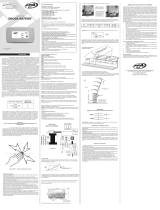 PPA Shock Battery El manual del propietario
PPA Shock Battery El manual del propietario
-
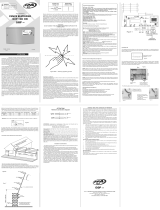 PPA 10K CRI Industrial Manual de usuario
PPA 10K CRI Industrial Manual de usuario
-
 PPA Deton Siren El manual del propietario
PPA Deton Siren El manual del propietario
-
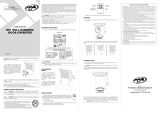 PPA BR1 - 500 Manual de usuario
PPA BR1 - 500 Manual de usuario
-
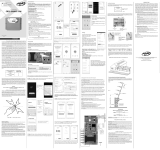 PPA Electrifier CR2S Smart On Manual de usuario
PPA Electrifier CR2S Smart On Manual de usuario
-
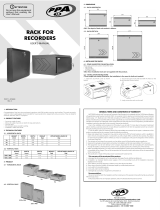 PPA Rack for Recorders Manual de usuario
PPA Rack for Recorders Manual de usuario
-
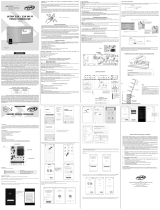 PPA ULTRA 22K SMART ON Manual de usuario
PPA ULTRA 22K SMART ON Manual de usuario
-
 PPA Good Light Plus Manual de usuario
PPA Good Light Plus Manual de usuario
-
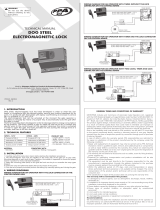 PPA Dog Steel Lock Manual de usuario
PPA Dog Steel Lock Manual de usuario
-
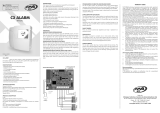 PPA C2 Manual de usuario
PPA C2 Manual de usuario
Otros documentos
-
Gallagher S20 Instrucciones de operación
-
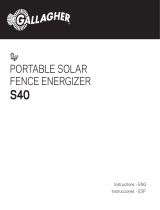 Gallagher S40 Instrucciones de operación
Gallagher S40 Instrucciones de operación
-
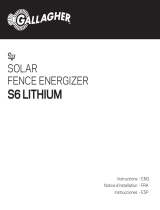 Gallagher 3E5307 Manual de usuario
Gallagher 3E5307 Manual de usuario
-
Gallagher M35 Instrucciones de operación
-
Gallagher S12 Instrucciones de operación
-
Gallagher M1100 Manual de usuario
-
Gallagher S10 Instrucciones de operación
-
Gallagher M5800i Instrucciones de operación
-
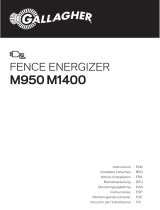 Gallagher M950 Instrucciones de operación
Gallagher M950 Instrucciones de operación














